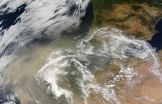Artificial photosynthesis could help make fuels, plastics and medicine
2015-04-29
(Press-News.org) The global industrial sector accounts for more than half of the total energy used every year. Now scientists are inventing a new artificial photosynthetic system that could one day reduce industry's dependence on fossil fuel-derived energy by powering part of the sector with solar energy and bacteria. In the ACS journal Nano Letters, they describe a novel system that converts light and carbon dioxide into building blocks for plastics, pharmaceuticals and fuels -- all without electricity.
Peidong Yang, Michelle C. Y. Chang, Christopher J. Chang and colleagues note that plants use photosynthesis to convert sunlight, water and carbon dioxide to make their own fuel in the form of carbohydrates. Globally, this natural process harvests 130 Terawatts of solar energy. If scientists could figure out how to harness just a fraction of that amount to make fuels and power industrial processes, they could dramatically cut our reliance on fossil fuels. So, Yang, Michelle Chang and Christopher Chang's teams wanted to contribute to these efforts.
The groups developed a stand-alone, nanowire array that captures light and with the help of bacteria, converts carbon dioxide into acetate. The bacteria directly interact with light-absorbing materials, which the researchers say is the first example of "microbial photoelectrosynthesis." Another kind of bacteria then transforms the acetate into chemical precursors that can be used to make a wide range of everyday products from antibiotics to paints.
INFORMATION:
The authors acknowledge funding from the U.S. Department of Energy, the Lawrence Berkeley National Laboratory, Howard Hughes Medical Institute, the National Science Foundation and the National Institutes of Health
The American Chemical Society is a nonprofit organization chartered by the U.S. Congress. With more than 158,000 members, ACS is the world's largest scientific society and a global leader in providing access to chemistry-related research through its multiple databases, peer-reviewed journals and scientific conferences. Its main offices are in Washington, D.C., and Columbus, Ohio.
To automatically receive news releases from the American Chemical Society, contact newsroom@acs.org.
Follow us:
Twitter
Facebook
ELSE PRESS RELEASES FROM THIS DATE:
2015-04-29
Psychology, biology, and mathematics have come together to show that the occurrence of altruism and spite - helping or harming others at a cost to oneself - depends on similarity not just between two interacting individuals but also to the rest of their neighbours.
According to this new model developed by researchers DB Krupp (Psychology) and Peter Taylor (Mathematics and Statistics, Biology) at Queen's and the One Earth Future Foundation, individuals who appear very different from most others in a group will evolve to be altruistic towards similar partners, and only ...
2015-04-29
Logic would dictate that consumers receiving new market information would jump at the chance to adjust their investments accordingly. In practice, however, many people associate change with loss of control. They crave the idea of permanence or closure to such an extent that they would rather freeze decisions in place even if, ironically, this puts them more at risk, according to a new study in the Journal of Marketing Research.
"The need for closure plays a central role in the way people make decisions," write authors David Disatnik and Yael Steinhart of Tel Aviv University. ...
2015-04-29
When trying to identify "good" customers, managers often ignore those who return products, or might even consider those customers non-ideal, decreasing the resources devoted to them. In the long term, however, satisfactory product return experiences can actually create a valuable long-term customer whose contributions far outweigh the associated costs, according to a new study in the Journal of Marketing Research.
"Product returns are no small part of the firm-customer exchange process, currently costing firms about $100 billion annually," write authors J. Andrew Petersen ...
2015-04-29
The latest Special Issue from ecancermedicalscience is dedicated to the memory of our late friend, Dr Mario Sideri.
The Special Issue, "Prevention of gynaecological cancers: in memory of Mario Sideri," consists of nine articles centred around Dr Sideri's favoured research topic.
Dr Sideri was one of the first doctors in the world to identify the connection between the human papillomavirus (HPV) and cervical cancer.
He served as the Director of the Preventive Gynecology Unit at the European Institute of Oncology (IEO) in Milan from 1994 until his tragic death in June ...
2015-04-29
As businesses move into international markets, they often do so with a "one size fits all" customer satisfaction strategy. But factors as basic as how consumers prioritize pricing and quality can differ sharply across cultures and economic systems, according to a new study in the Journal of International Marketing. Success will depend in part on understanding these perceptions across cultures.
"A company's success abroad will depend in part on understanding how people of different cultures sometimes perceive value very differently," write authors Forrest V. Morgeson III ...
2015-04-29
Jena (Germany) Spring has arrived in Europe with mild temperatures and sunshine. Where just a few weeks ago the ground was frozen and partly covered in snow and ice, it is now thawing. This doesn't only have an impact on the flora and fauna. Thawing results in soil and the groundwater at airports being impacted by chemicals, which are contained in melt water. The reason: Airports have to use de-icing agents during the winter, which end up on unpaved areas and infiltrate into the soils during snowmelt.
"Admittedly, airport operators in EU-countries are compelled to sustain ...
2015-04-29
Children who view television as little as an hour a day are significantly more likely to be overweight or obese and gain more unhealthy weight over time, according to a new study from the University of Virginia School of Medicine. Based on the findings, the researchers say physicians should encourage families to restrict young children's TV viewing to prevent unhealthy weight gain.
Many previous studies that have examined the link between television and childhood obesity evaluated the effects of watching at least two hours a day; the UVA researchers, on the other hand, ...
2015-04-29
Spanish and Portuguese researchers have analysed the composition and radiative effect of desert aerosols during two episodes which simultaneously affected Badajoz (Spain) and Évora (Portugal) in August 2012. Results show that the intrusion of dust from the Sahara Desert caused radiative cooling of the Earth's surface.
Atmospheric aerosols (solid or liquid particles suspended in the atmosphere) are difficult to examine for various reasons. Firstly, they remain in the atmosphere for a short time and secondly, their cause may be natural or anthropogenic.
Yet there ...
2015-04-29
(PHILADELPHIA) - Multiple sclerosis (MS) is caused by immune cells that activate a cascade of chemicals in the brain, attacking and degrading the insulation that keeps neuronal signals moving. These chemicals, called cytokines, drive the inflammation in the brain, attracting more immune cells, and causing the debilitating disease marked by loss of neurological function. Researchers have long debated which cytokines drive the disease and which are merely accessory. Now, a study published online April 27th, in the Journal of Immunology, confirms that the cytokine GM-CSF ...
2015-04-29
29.04.2015: In these days, it was again tragically demonstrated that the Himalayas are one of the most active geodynamic regions of the world. Landslides belong to the most important geohazards. Besides earthquakes they are triggered mainly by strong rainfall events. A team of scientists from Nepal, Switzerland and Germany was now able to show how erosion processes caused by the monsoon are mirrored in the sediment load of a river crossing the Himalaya.
The geoscientists used data from two stations along the Kali Gandaki, a river that traverses the Himalaya from North ...
LAST 30 PRESS RELEASES:
[Press-News.org] Artificial photosynthesis could help make fuels, plastics and medicine

